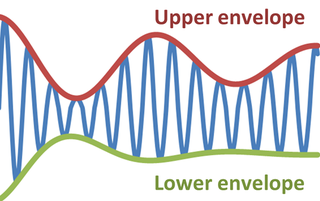 W
WAmplitude modulation (AM) is a modulation technique used in electronic communication, most commonly for transmitting messages with a radio carrier wave. In amplitude modulation, the amplitude of the carrier wave is varied in proportion to that of the message signal, such as an audio signal. This technique contrasts with angle modulation, in which either the frequency of the carrier wave is varied as in frequency modulation, or its phase, as in phase modulation.
 W
WRonald Hugh Barker FIEE was an Irish physicist and inventor of Barker code for digital synchronisation. He was a member of the Institution of Engineering and Technology (IET) for 70 years. Born in Dublin, Ireland, Barker had an erratic education but excelled in mathematics, becoming keen on electronics. He is best known for his ground-breaking work on synchronising digital communication systems and framing of received data, using digital codes. These digital codes are known as Barker code. The method was initially researched at SRDE Royal Signals Research Establishment, just after World War II for use in radar, rocket telemetry and digital speech. In 1952, Barker found 7 Barker sequences up to a length of 13 useful for correlation. These sequences are widely used in most data transmissions today. Examples of applications are radar, mobile phone technology, telemetry, digital speech, ultrasound imaging and testing, GPS and WiFi, etc.
 W
WIn digital communications, chirp spread spectrum (CSS) is a spread spectrum technique that uses wideband linear frequency modulated chirp pulses to encode information. A chirp is a sinusoidal signal of frequency increase or decrease over time. In the picture is an example of an upchirp in which the frequency increases linearly over time. Sometimes the frequency of upchirps increase exponentially over time.
 W
WWireless telegraphy or radiotelegraphy is transmission of telegraph signals by radio waves. Before about 1910, the term wireless telegraphy was also used for other experimental technologies for transmitting telegraph signals without wires, such as electromagnetic induction, and ground conduction telegraph systems.
 W
WIn physics and engineering, the envelope of an oscillating signal is a smooth curve outlining its extremes. The envelope thus generalizes the concept of a constant amplitude into an instantaneous amplitude. The figure illustrates a modulated sine wave varying between an upper and a lower envelope. The envelope function may be a function of time, space, angle, or indeed of any variable.
 W
WFrequency modulation (FM) is the encoding of information in a carrier wave by varying the instantaneous frequency of the wave. The technology is used in telecommunications, radio broadcasting, signal processing, and computing.
 W
WPhase-fired control (PFC), also called phase cutting or "phase angle control", is a method for power limiting, applied to AC voltages. It works by modulating a thyristor, SCR, triac, thyratron, or other such gated diode-like devices into and out of conduction at a predetermined phase of the applied waveform.
 W
WIn electronics, ring modulation is a signal processing function, an implementation of frequency mixing, performed by creating multiple frequencies from those of the two signals, where one is typically a sine wave or another simple waveform and the other is the signal to be modulated. A ring modulator is an electronic device for ring modulation. A ring modulator may be used in music synthesizers and as an effects unit.
 W
WIn radio communications, single-sideband modulation (SSB) or single-sideband suppressed-carrier modulation (SSB-SC) is a type of modulation used to transmit information, such as an audio signal, by radio waves. A refinement of amplitude modulation, it uses transmitter power and bandwidth more efficiently. Amplitude modulation produces an output signal the bandwidth of which is twice the maximum frequency of the original baseband signal. Single-sideband modulation avoids this bandwidth increase, and the power wasted on a carrier, at the cost of increased device complexity and more difficult tuning at the receiver.
 W
WSlow Scan television (SSTV) is a picture transmission method used mainly by amateur radio operators, to transmit and receive static pictures via radio in monochrome or color.
 W
WIn telecommunication and radio communication, spread-spectrum techniques are methods by which a signal generated with a particular bandwidth is deliberately spread in the frequency domain, resulting in a signal with a wider bandwidth. These techniques are used for a variety of reasons, including the establishment of secure communications, increasing resistance to natural interference, noise, and jamming, to prevent detection, to limit power flux density, and to enable multiple-access communications.